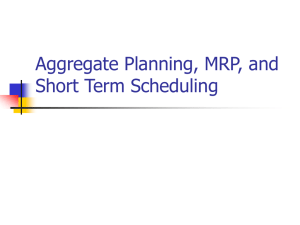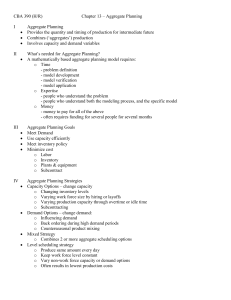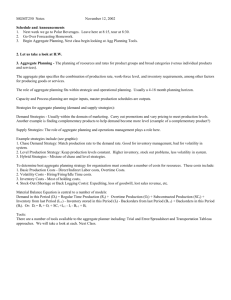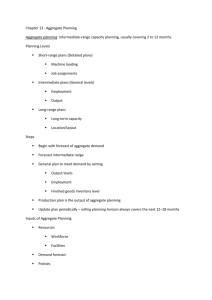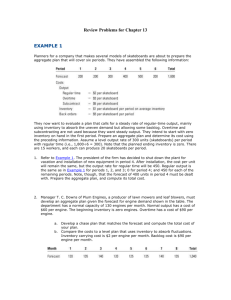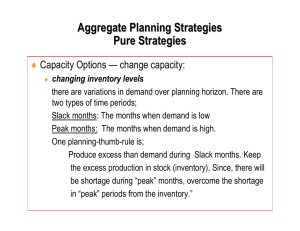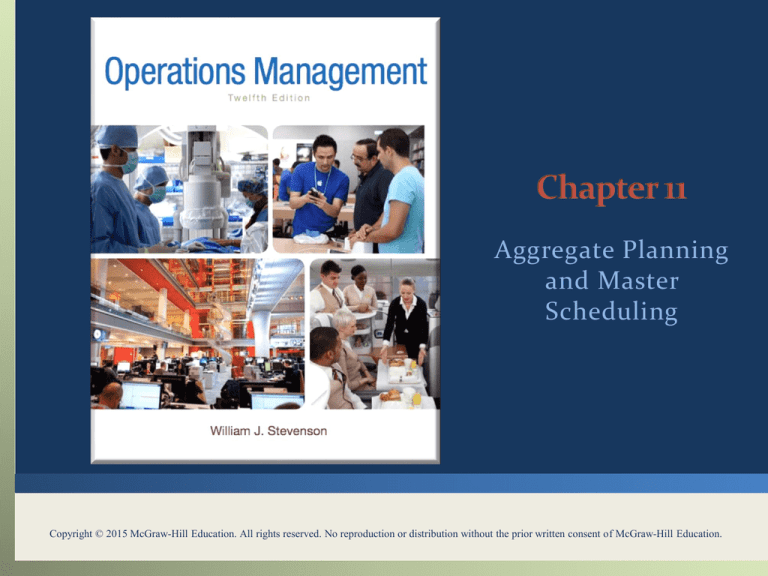
Aggregate Planning
and Master
Scheduling
Copyright © 2015 McGraw-Hill Education. All rights reserved. No reproduction or distribution without the prior written consent of McGraw-Hill Education.
You should be able to:
LO 11.1
LO 11.2
LO 11.3
LO 11.4
LO 11.5
LO 11.6
LO 11.7
Explain what aggregate planning is and how it is useful
Identify the variables decision makers have to work with in
aggregate planning
Describe some of the strategies that can be used for meeting
uneven demand
Describe some of the graphical and quantitative techniques
planners use
Prepare aggregate plans and compute their costs
Describe the master scheduling process and explain its
importance
Disaggregate an aggregate plan
11-2
Aggregate planning
Intermediate-range capacity planning that typically
covers a time horizon of 2 to 18 months
Useful for organizations that experience seasonal, or
other variations in demand
Goal:
Achieve a production plan that will effectively utilize the
organization’s resources to satisfy demand
LO 11.1
11-3
Why do organizations need to do aggregate planning?
Planning
It takes time to implement plans
Strategic
Aggregation is important because it is not possible to predict
with accuracy the timing and volume of demand for individual
items
It is connected to the budgeting process
It can help synchronize flow throughout the supply chain; it affects
costs, equipment utilization; employment levels; and customer
satisfaction
LO 11.1
11-4
Resources
Workforce/production rates
Facilities and equipment
Demand forecast
Policies
Workforce changes
Subcontracting
Overtime
Inventory levels/changes
Back orders
LO 11.2
Costs
Inventory carrying
Back orders
Hiring/firing
Overtime
Inventory changes
subcontracting
11-5
Total cost of a plan
Projected levels of
Inventory
Output
Employment
Subcontracting
Backordering
LO 11.2
11-6
Maintain a level workforce
2. Maintain a steady output rate
3. Match demand period by period
4. Use a combination of decision variables
1.
LO 11.3
11-7
Level capacity strategy:
Maintaining a steady rate of regular-time output while
meeting variations in demand by a combination of
options:
inventories, overtime, part-time workers, subcontracting, and
back orders
Chase demand strategy:
Matching capacity to demand; the planned output for a
period is set at the expected demand for that period.
LO 11.3
11-8
General procedure:
1. Determine demand for each period
2. Determine capacities for each period
3. Identify company or departmental policies that are pertinent
4. Determine unit costs
5. Develop alternative plans and costs
6. Select the plan that best satisfies objectives. Otherwise return to step
5.
LO 11.4
11-9
Hospitals:
Aggregate planning used to allocate funds, staff, and supplies to meet the
demands of patients for their medical services
Airlines:
Aggregate planning in this environment is complex due to the number of
factors involved
Capacity decisions must take into account the percentage of seats to be
allocated to various fare classes in order to maximize profit or yield
Restaurants:
Aggregate planning in high-volume businesses is directed toward
smoothing the service rate, determining workforce size, and managing
demand to match a fixed capacity
Can use inventory; however, it is perishable
LO 11.6
11-10
The resulting plan in services is a time-phased projection
of service staff requirements
Aggregate planning in manufacturing and services is
similar, but there are some key differences related to:
1.
2.
3.
4.
LO 11.6
Demand for service can be difficult to predict
Capacity availability can be difficult to predict
Labor flexibility can be an advantage in services
Services occur when they are rendered
11-11
Master schedule:
The result of disaggregating an aggregate plan
Shows quantity and timing of specific end items for a
scheduled horizon
LO 11.7
11-12
The heart of production planning and control
It determines the quantity needed to meet demand from all sources
It interfaces with
Marketing
Capacity planning
Production planning
Distribution planning
Provides senior management with the ability to determine whether
the business plan and its strategic objectives will be achieved
LO 11.7
11-13
Period
1
2
“frozen”
(firm or
fixed)
LO 11.7
3
4
5
“slushy”
somewhat
firm
6
7
8
9
“liquid”
(open)
11-14
Inputs
Outputs
Beginning inventory
Forecast
Customer orders
LO 11.7
Projected inventory
Master
Scheduling
Master production schedule
Uncommitted inventory
11-15

